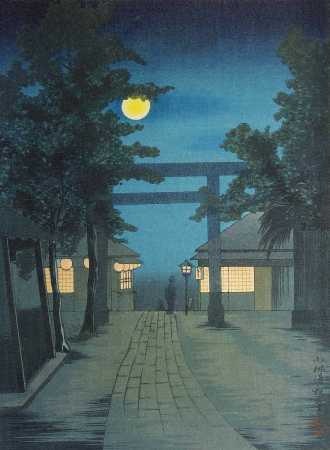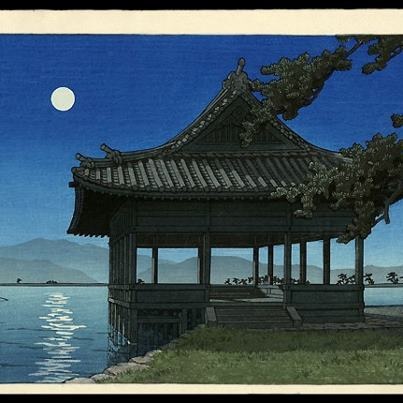Blue Moon Blog: Part I
The moon returns night after night, and we never tire of the repetition. I'm hoping you'll feel the same way about three consecutive JOK Notebook entries about the moon!
When two full moons appear within a calendar month, the second is a "blue moon." What, then, do you call it when October contains three blogs about the moon? The best I can come up with "Blue Moon Blog," but that doesn't seem to capture just how many times the full moon will shine on Joy o' Kanji this month!

"Shrine Visit at Night"
Kiyochika Kobayashi (1847–1915), ca. 1910.
Last week, before posting my Moon River entry, I looked high and low for woodblock prints with moons. The day after I published it, a glorious one emerged on Facebook. Of course it would happen that way! I'm sharing it here as an act of artistic esprit de l'escalier.
That's partly why I'm having another go at this moon topic, but it's a minor reason compared with all the activity coming out of Osaka. I know someone there—let's call him the Man from Osaka. We've met only twice, once on a train in New Zealand in 2009, when we struck up a two-hour Japanese conversation that I barely understood, and again in Osaka this summer, when my incomprehension lasted more than six hours. I kept turning to my dictionary, but on at least 10 occasions it didn't contain the words he had used.
His Japanese is far above my level. It's far above nearly everyone's level. His hardest sentences have stumped my native speaker friends and a top-notch proofreader. Just about anything the Man from Osaka writes is dense with literary allusions, wordplay, references to artworks and songs, discussions of tribes and places I've never heard of, comments about thinkers like Max Weber, and analyses of geopolitical disputes, just to name some themes off the top of my head.
I recently spent more than eight hours dissecting two emails from him, and at the end there was still a great deal that I didn't understand. These emails have kept me so busy that I haven't even had time to respond to them yet!
Through his writing, the Man from Osaka prompts me to go off on explorations that feel as if they could last infinitely. Though I'm not equal to the tasks he sets out for me, the challenge somehow keeps me ambitious and hopeful. Dare I say that it makes me shoot for the moon?

"Shrine in the Moonlight"
Hasui Kawase (1883–1957), early 1920s.
I came across this image belatedly, as well.
After reading my JOK Notebook entry from last week, The Man from Osaka wrote quite a long email about the moon. Each comment sent me down a separate trail. I'll call them moon trails, though "snail trails" might be more accurate, considering the pace at which I traveled. I'll share two of these trails with you now, saving the rest for next week.
Moon Trail 1: 尽
He began his moon discussion with this astoundingly compact sentence:
月尽くしですね。
(Your JOK Notebook entry) was full of the moon, wasn’t it?
月* (つき: moon); -尽くし (-づくし: full of (something))
In other words, I did the moon topic fully. It's almost as if I created a full moon!
I love the way 月 and 尽 stand together as near mirror images. And I didn't know about the ultra-concise "noun + -尽くし" structure. A true revelation! (This is the positive version of "noun + -だらけ," which means "full of" in a negative sense, as in, "My writing is full of mistakes.")
The 尽 kanji is new to me, as well. He used it again in the next sentence, which my proofreader has simplified for us:
物事をフォーカスして思考する姿勢には、興味が尽きません。
Given the way you focus on things, I will never lose interest.
物事 (ものごと: things; everything); 思考 (しこう: thought; consideration); 姿勢 (しせい: attitude; approach); 興味 (きょうみ: interest); 尽きる (つきる: to run out)
The red part begins with the yomi of つき. That's the yomi of the moon!
To take a trail off the trail, this discussion of -尽くし prompted my proofreader to recall the following oxymoronic expression:
無い無い尽くし (ないないづくし: there’s absolutely nothing; one has absolutely nothing)
To understand this, imagine that you had absolutely nothing. You would say something like this:
あれもない、これもない、ここにもない、あそこにもない。
I have none of those, none of these, none here, none there.
This phrase about nothingness is full of (尽くし) ないs! Thus, 無い無い尽くし makes sense, after all!
Moon Trail 2: Poetic Terms
Another sentence by the Man from Osaka introduced poetic terms about the moon:
朧月、十六夜の月、夜半の月等美しいことばです。
"Hazy moon," "16-day-old moon," midnight moon," and so on, are beautiful words.
朧月 (おぼろづき: hazy moon, esp. on a spring night); 十六夜 (いざよい: 16-day-old moon); 夜半 (やはん or よわ: midnight); 等 (など: etc.); 美しい (うつくしい: beautiful)
The first kanji, which combines an old dragon (龍) with the moon, is familiar to me somehow, but why? Ah, yes, I wrote about this non-Joyo character at the very end of Radical Note 74 on 月, the "moon" radical.
The Japanese have a term for "16-day-old moon"?! I shouldn't be surprised, but of course I am! According to Breen's dictionary, the definition of 十六夜 already includes "moon," so one could consider it redundant to add の月. I double-checked this with my proofreader, who said that because 十六夜 literally means "16th (十六 ) night (夜)," the idea of a moon is implicit. However, it's also fine to include の月, just so that the moon is perfectly clear.
Then he produced this nugget. His sources say that the yomi いざよい is the noun form of the archaic verb いざよう (to hesitate), which is written in kanji as 猶予う. The yomi いざよい, which originally meant “hesitation,” was applied to the kanji 十六夜 because a 16-day-old moon comes up later than a 15-day-old one (which is a full moon), as if it were “hesitating.” So いざよいのつき is “the moon of hesitation”! How wonderful is that?!
Have a great weekend. If you can, live a little by the light of the moon!

Comments